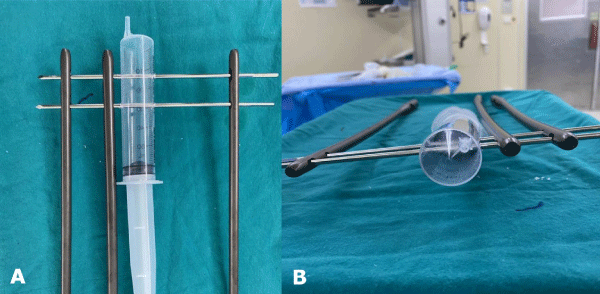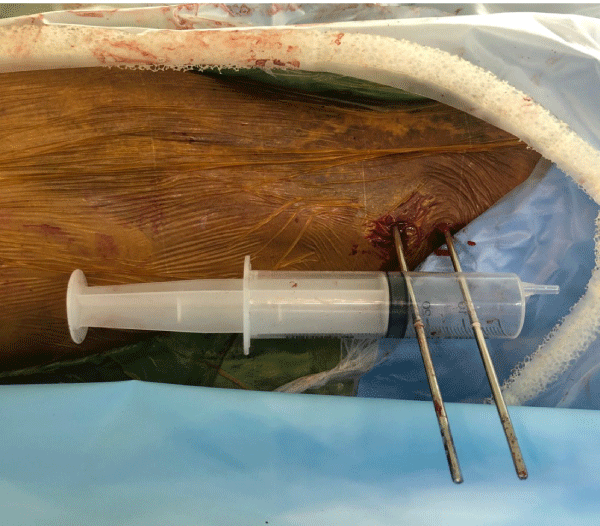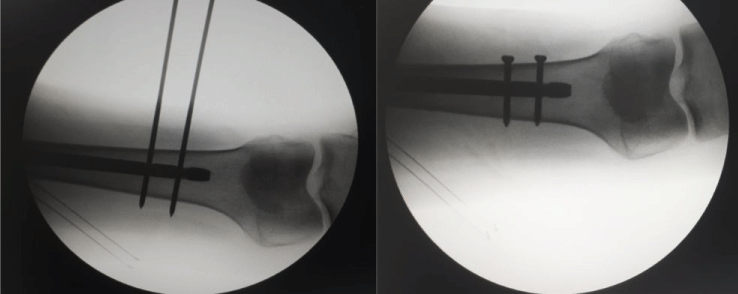A Simple Technique to Facilitate Distal Locking Screws Placement in Intramedullary Nailing
Abstract
Background: Distal locking screws placement in Intramedullary nail fixation for treatment of long bone fracture is important step and sometimes lead to increase operative time and radiologic exposure.
Study Design: Technical note.
Purpose: We propose a simple, efficient, and low-cost technique for the distal locking screws placement using the first screw placement as a guide for the second screw.
Methods: The prepared 50- ml- plastic syringe with two parallel Steinmann pins were used as a guided for the distal locking screws placement. After achieving the first locking hole pin placement by freehand technique, the second pin can be placed easily to the second locking hole.
Results and Conclusion: We expected our proposed technique be able to shorten operative time, reduce fluoroscopic exposure and be reproducible in all levels of orthopedic surgeons.
Keywords
Intramedullary nail, Distal locking screw, Technique
Introduction
Placement of distal locking screws in an intramedullary nail (IMN) is usually performed by freehand 'perfect circles' technique [1]. Twice repetition for two screws insertion might increase operative time and radiologic exposure. We propose a simple, short time and low-cost technique using the first screw placement as a guide for the second screw.
Surgical Technique
On the sterile preparation table, two 3.5 mm Steinmann pins are drilled through a 50- ml- plastic syringe in line with the distal locking holes of IMN. Both Steinmann pins must be parallel in the horizontal plane and in the axial plane. The other IMNs can be used as a parallel guide (Figure 1). Plastic dust, as a result of this step, must be washed out. Then one of two pins is removed from the syringe. After 'perfect circles' of the distal locking holes have been achieved, the tip of the remaining Steinmann pin is placed to the center of the first locking hole, preferring to start in the static locking hole. The syringe is used as a handle for controlling the position of the pin [2]. The first pin is introduced through the near cortex, passes through the IMN locking hole, and then is drilled through the far cortex to avoid cortical breakage. During performing this step, the second locking hole longitudinal alignment is identified.
The second Steinmann pin is re-inserted through the syringe, and passed through the identified skin, touching the near cortex. For this step, the first Steinmann pin acts as center of rotation, while the fixed distance between two pins acts as radius, then just rotates the second pin to the correct position related to the second locking hole, confirmed by fluoroscopy. After near cortex passing is achieved, the pin will be guided through the nail and then directed precisely to the far cortex (Figure 2). And finally, measuring and placing of each locking screw are performed (Figure 3).
Discussion
Intramedullary nail fixation is a common orthopaedic operation. Distal locking screws placement is always challenging not only to the junior surgeon, but also sometimes to the senior one. Several techniques of the screws placement have been published, from simple fluoroscopic technique to more sophisticated navigating system. In the 2-parallel distal locking design intramedullary nail, we propose a technique that facilitates placement of the second distal locking screw by using a determined distance between both distal locking holes and the parallel direction of both screws.
It remarkably reduces operative time and fluoroscopic exposure. To achieve the perfect parallel of the pin-syringe assembly which is the most critical step for our proposed technique. It can be performed manually by assisted aiming and using other IMNs as guidance, and possible with prefabricated aiming devices for each type of IMN. To prevent the far cortex breakage which possibly occurs after continuous tapping the Steinmann pin through the far cortex, we recommend changing to motorized drilling.
Conclusion
For this simple, efficient, and low-cost proposed technique for the distal locking screws placement using the first screw placement as a guide for the second screw, we expected it to be able to shorten operative time, reduce fluoroscopic exposure and be reproducible in all levels of orthopedic surgeons.
Conflict of Interest
We have no known conflict of interest to disclose.
Previous presentation of the work: None.
References
- Stevens JM, Faortha S, Shiels T, et al. (2019) Technique for guiding distal locking screws into intramedullary nails. Techniques in Orthopaedics 36: 188-189.
- Bonshahi AY, Cowey A, Vhadra R (2003) A Simple Distal Interlocking Aid for Intramedullary Nails. J Postgrad Med 49: 99-100.
Corresponding Author
Pratya Jaratjitwilai, MD, Geisinger Medical Center, Danville, 16 Woodbine Lane, PA17821, USA.
Copyright
© 2022 Holbert JA, et al. This is an open-access article distributed under the terms of the Creative Commons Attribution License, which permits unrestricted use, distribution, and reproduction in any medium, provided the original author and source are credited.







